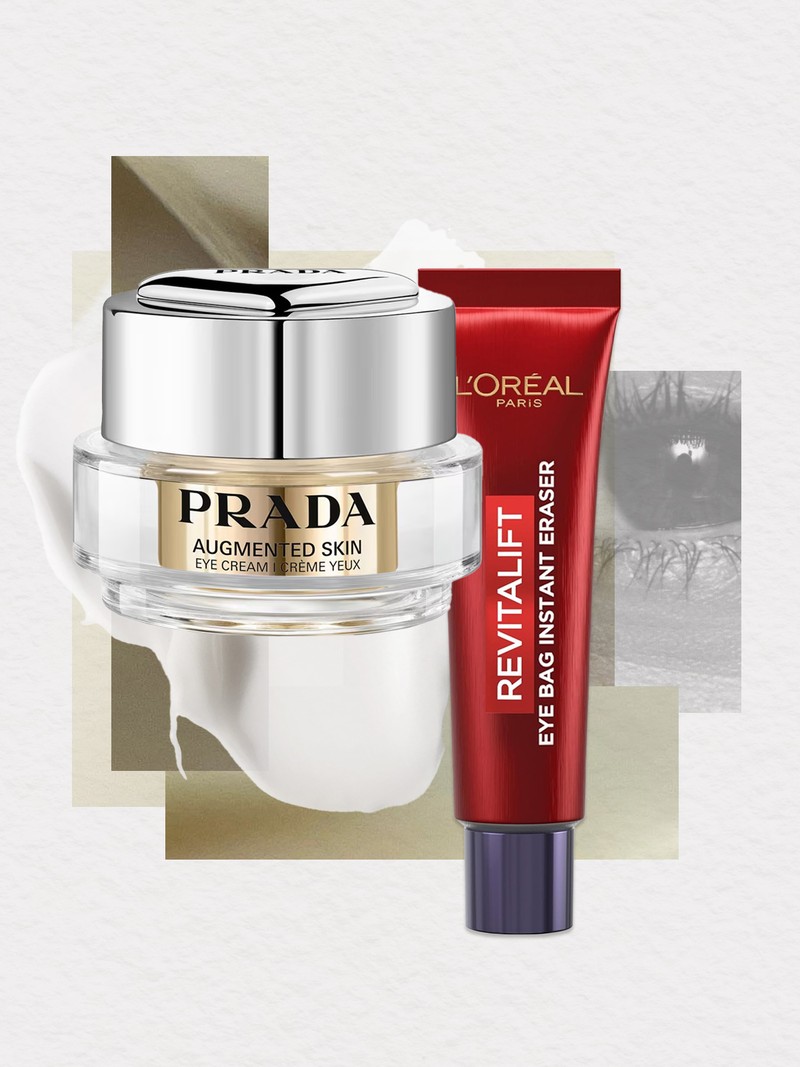
4 Ways To Tackle Dark Circles, Fine Lines & Puffiness

Best For Dark Circles
When it comes to brightening dark circles, formulas containing caffeine are a great shout. The Inkey List clearly agrees, as its excellent Caffeine Eye Cream is full of it, harnessing the ingredient’s vasoconstrictor properties to constrict blood vessels and fluid build-up that contribute to under-eye shadows. It’s also an antioxidant and protects against damaging oxidative stress. Vitamin K is another key ingredient to have on your radar – especially if your dark circles are the result of vascular issues or thinner skin. Goldfaden MD’s Bright Eye is a bit of an industry hidden gem, as it contains plenty of vitamin K (alongside other actives like soy peptide and organic red tea) which helps to improve circulation and reduce blood pooling under the eyes.
Caffeine Eye Cream, £10 | The Inkey List
Bright Eyes, £48 | Goldfaden MD

Best For Puffiness
One way to tackle eye bags is to invest in a product like Prada’s Augmented Skin Eye Cream, a balm-to-serum formula which contains active ingredients – including its AAA complex (amino acids and ashwagandha) – that promote collagen productions and deliver a heavy dose of hyaluronic acid. In addition to soothing and brightening, it comes with an ergonomically shaped metal gua sha that, when kept in the fridge, is ideal for smoothing and de-puffing the skin. If you’re after instant results, give L'Oréal Paris’ Revitalift Laser Eye Bag Instant Eraser a try. This innovative formula uses clever gel-to-tape technology to instantly smooth, tighten and brighten the under-eye area. While the results aren’t permanent, it’ll last until it’s time for your evening cleanse.
Augmented Skin Eye Cream, £260 | Prada
Revitalift Laser Eye Bag Instant Eraser, £29.99 | L'Oréal Paris

Best For Fine Lines
If fine lines and wrinkles around the eye area are beginning to bother you, Clarins Total Eye Lift is loaded with potent plant actives proven to boost collagen and plump out lines, as well as improve elasticity and radiance. Despite being a heavy hitter, the formula itself is featherlight. If it’s time for a more targeted attack, you can’t go wrong with Murad’s Retinal ReSculpt Eye Treatment which uses retinal, a powerful form of vitamin A, in an encapsulated, non-irritating form to address drooping contours and folds over time. To help smooth fine lines without resorting to a needle, try Wildsmith’s Active Super Eye Serum, which contains two botanical peptides, argireline peptides and paracress, all of which are known for their muscle-relaxing, collagen-boosting properties.
Total Eye Lift, £66 | Clarins
Retinal ReSculpt Eye Treatment, £92 | Murad
Active Super Eye Serum, £100 | Wildsmith

Best For Fatigue
The delicate skin under the eyes is one of the first places to show signs of fatigue – which can include dull, greying skin and hollowed out contours. To improve the look of just about everything, Dior’s new Capture Pro-Collagen Shot u ses a biotechnology-derived collagen fragment alongside its own lifting technology to refresh the whole area. The ice-cold metal applicator is especially welcome after a late night. Another great option is MZ SKIN’s Intensive Bio-Placenta Eye Cream, created by oculoplastic surgeon Dr Maryam Zamani, which uses bio-mimetic placenta to target lines, hydrate and brighten everything up. A cocktail is always a good idea, especially when it’s in the form of a punchy peptide cocktail. Happily, Paula’s Choice Pro-Collagen Peptide Firming Eye Serum is just that and uses a host of four proven peptides to lift, refine and refresh the eye area, including the lids. If you enjoy the brightening effects of vitamin C in your skincare routine, why not continue with Omorovicza's Daily Vitamin C Eye? A punchy blend of vitamins C, E and A derived from Mediterranean microalgae, arnica, holy herb and ginger extract are also in there to improve radiance over time.
Capture Pro-Collagen Shot, £68 | Dior
Intensive Bio-Placenta Eye Cream, £180 | MZ Skin
Pro-Collagen Peptide Firming Eye Serum, £41 | Paula's Choice
Daily Vitamin C Eye, £110 | Omorovicza
Follow @GEORGIALDAY
DISCLAIMER: We endeavour to always credit the correct original source of every image we use. If you think a credit may be incorrect, please contact us at info@sheerluxe.com.





